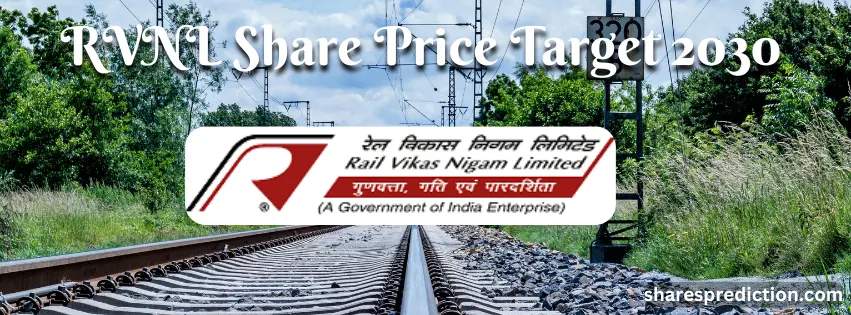Rail Vikas Nigam Limited (RVNL) has grown from a small public sector company to one of India’s most active infrastructure companies. It has given shareholders great returns over the past three years thanks to good execution, growing capital spending on trains, and reforms endorsed by the government.
As investors look to the future, the most important question is: What may the RVNL share price target 2030?
In this article, we’ll evaluate RVNL’s growth potential, future revenue trajectory, financial performance forecast, and thorough RVNL share price target 2030 projections – including both optimistic and conservative scenarios.
About RVNL (Rail Vikas Nigam Limited)
Rail Vikas Nigam Limited is a Government of India PSU under the Ministry of Railways, responsible for the execution of critical railway projects — including track doubling, electrification, metro lines, and freight corridors.
Since its incorporation in 2003, RVNL has become a crucial pillar in India’s infrastructure modernization drive.
Key Company Highlights
-
Industry: Railway Infrastructure & Construction
-
Ownership: Government of India (~78%)
-
Market Cap (2025): ₹80,000+ crore
-
Core Projects: Metro, High-Speed Rail, Electrification, Multi-Modal Transport
-
Presence: India + select overseas projects
RVNL’s Journey So Far
Over the past few years, RVNL has delivered extraordinary returns to investors:
| Year | Approx. Share Price | Key Growth Driver |
|---|---|---|
| 2022 | ₹40 | Railway Capex Cycle |
| 2023 | ₹130 | Strong Order Wins |
| 2024 | ₹380 | Market Re-rating |
| 2025 | ₹600+ | PSU & Infra Boom |
| 2030 (Projected) | ₹820–₹870 | Long-Term Expansion |
From ₹40 to ₹600+ within three years, RVNL’s growth showcases both earnings expansion and structural revaluation in India’s PSU landscape.
RVNL Share Price Target 2030 (Forecast & Scenarios)
After analyzing RVNL’s fundamentals, revenue trends, and project pipeline, here’s a detailed breakdown of the RVNL share price target 2030 under different scenarios:
| Scenario | Target Price (2030) | CAGR (2025–2030) | Outlook |
|---|---|---|---|
| Base Case | ₹1,800 | 20–22% | Sustainable growth |
| Bull Case | ₹2,000+ | 24–25% | Strong order inflows & margin expansion |
| Bear Case | ₹1,400 | 16–17% | Slow project execution or reduced capex |
Summary
Under the base scenario, RVNL’s share could double by 2030, driven by consistent revenue growth, improved profit margins, and stable dividend payouts.
Key Drivers Behind RVNL Share Price Target 2030
1. Huge Railway Capex Pipeline
The Indian government still puts a lot of money into modernizing the railways, with an annual budget of ₹2.5 lakh crore+ set aside for the industry. RVNL, as a core PSU executor, will directly benefit.
2. Strong Order Book Visibility
RVNL’s order book is worth more than ₹80,000 crore as of FY2025, which means they may count on long-term revenue and get more out of their operations.
3. Getting into Metro and International Projects
Expansion into metro projects and overseas operations (such as Africa and the Middle East) will help minimize dependence on Indian Railways alone.
4. Improved Financial Performance
Steady growth in revenue, profit, and ROE reflects RVNL’s shift from a government executor to a commercially effective firm.
5. Consistent Dividends & PSU Re-Rating
Regular dividends and a stronger view of PSUs among investors might boost valuation upgrades until 2030.
| Parameter | FY2025E | FY2030E (Projected) | Growth |
|---|---|---|---|
| Revenue | ₹25,000 Cr | ₹60,000+ Cr | 20% CAGR |
| Net Profit | ₹1,650 Cr | ₹4,000+ Cr | 19–20% CAGR |
| EPS | ₹7.8 | ₹19–21 | — |
| ROE | 23% | 25%+ | Improving |
| Dividend Yield | ~2% | ~2.5% | Steady |
If RVNL maintains this momentum, the RVNL share price target 2030 of ₹1,700–₹2,000 becomes not only achievable but potentially conservative.
Technical Outlook (Long-Term Trend)
From a long-term technical standpoint, RVNL is in a multi-year uptrend, forming higher highs and higher lows.
If the price sustains above ₹550–₹600 support zones, the long-term projection favors a gradual move toward ₹900+ levels by 2030.
Future Growth Opportunities
-
Expansion in metro and rapid transit projects
-
Participation in Dedicated Freight Corridors
-
Partnerships in Make in India & Atmanirbhar Bharat initiatives
-
Global infrastructure contracts through JV models
Risks & Challenges
-
Heavy dependence on government orders
-
Possible project delays or funding constraints
-
High valuation risk post-rerating
-
Global commodity price volatility affecting input costs
Should You Invest in RVNL for 2030?
RVNL offers one of the most compelling long-term PSU stories in India’s infrastructure sector. Its predictable cash flow, visible project pipeline, and government backing make it ideal for investors seeking steady compounding returns.
However, investors should:
-
Avoid chasing short-term rallies
-
Invest through SIP or staggered entries
-
Hold with a 5+ year horizon for maximum gains
RVNL Share Price Forecast: 2025 to 2030
| Year | Target Range | View |
|---|---|---|
| 2025 | ₹450 – ₹500 | Positive |
| 2026 | ₹550 – ₹650 | Bullish |
| 2027 | ₹700 – ₹720 | Bullish |
| 2028 | ₹800 – ₹820 | Sustained Growth |
| 2030 | ₹820 – ₹870 | Long-Term Bullish |
FAQs on RVNL Share Price Target 2030
1. What is the RVNL share price target for 2030?
The RVNL share price target 2030 is projected between ₹820 and ₹870, based on steady earnings growth and infrastructure expansion.
2. Can RVNL become a ₹2,000 stock by 2030?
Yes. If RVNL maintains 18–20% CAGR in revenue and profit, it can comfortably cross ₹1,000 by 2030.
3. Is RVNL a good long-term investment?
Absolutely. With solid fundamentals, consistent dividend payouts, and strong government support, RVNL remains one of the best long-term PSU bets.
4. What factors could drive RVNL’s growth till 2030?
Expansion in metro projects, high-speed rail corridors, and foreign project participation could significantly boost revenues.
5. Does RVNL have international operations?
Yes. RVNL has started taking up international contracts in countries like Nepal, Bangladesh, and parts of Africa.
6. What are the risks for long-term investors?
Delays in government project clearances, valuation corrections, or policy changes may impact near-term performance.
7. How does RVNL compare to IRCON or RITES?
While IRCON and RITES are also strong PSUs, RVNL has shown superior order growth and execution scale, giving it a leading edge.
8. Will RVNL continue to pay dividends till 2030?
Yes. Given its consistent profitability, RVNL is likely to maintain regular dividend payouts with a 1.5–2.5% yield.
Conclusion
RVNL’s long-term story is backed by India’s inevitable infrastructure revolution.
With excellent financials, robust execution, and rising worldwide footprint, the RVNL share price goal 2030 of ₹820–₹870 looks attainable — and potentially modest.
For patient, long-term investors, RVNL is not simply a PSU company — but an essential position in India’s infrastructure growth decade.
To explore detailed forecasts for 2025, 2035, 2040, 2045, and 2050, read my complete analysis here:
RVNL Share Price Target 2025–2050: Long-Term Forecast & Vision

Disclaimer
The information provided in this blog is for educational purposes only and does not constitute financial advice. Investors should research and consult with a financial advisor before making investment decisions.
Call to Action
Stay updated with the latest trends and forecasts by visiting sharesprediction regularly. Our comprehensive analyses and insights can help you make informed investment decisions.

